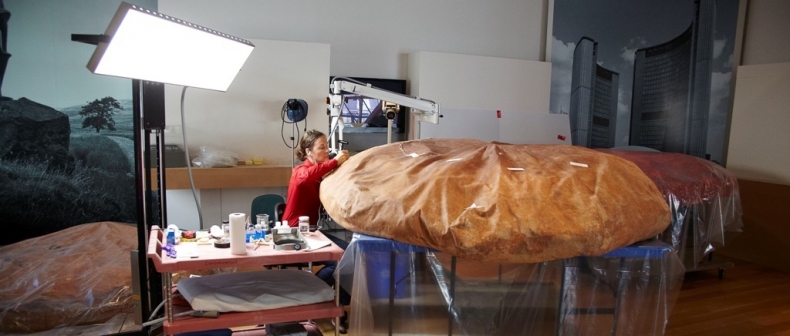
AGO Conservator Sherry Phillips works on Floor Burger. Credit: Claes Oldenburg, Floor Burger, 1962. Media: canvas filled with foam rubber and cardboard boxes, painted with acrylic paint. Copyright Art Gallery of Ontario.
For the average gallery goer, the world of art conservation is still largely a mystery. Up until recently, conservation projects at the Art Gallery of Ontario happened behind the vault-like doors of the institution’s conservation department. This past winter, visitors had the opportunity to see art conservation in progress for the first time ever, as conservators undertook the restoration of Claes Oldenburg’s Floor Burger (1962). The work was conducted in the Irina Moore Gallery, and visitors were invited to watch and ask questions. The work was also documented on the AGO’s Art Matters blog.
Intrigued by the unique challenges conservators have to overcome when restoring such unconventional pieces, I met with Maria Sullivan, Conservation Manager at the AGO, and Gregory Humeniuk, Curatorial Assistant of Canadian Art, to tour the department and find out what it’s like to work as an Art Conservator at the AGO.
Getting access to this exclusive space is a rarity for an outsider. Priceless pieces of art, be they paintings, prints, or sculptures, cover most surfaces in the large space. I even get a chance to see the complete Floor Burger, sitting in wait for its trip to New York’s Museum of Modern Art this spring. In this conservation setting, I get closer to it than to any art in any gallery I’ve ever been. Scaffolding and a makeshift perch of plywood and foam hover over the approximately four-foot tall soft sculpture, allowing for contemporary art conservator Sherry Phillips to get to the hard to reach parts. When the Floor Burger leaves the AGO, it will be moved using the gallery’s enormous freight elevator. The door to it alone is the size of the façade of my house and it can hold an entire car.
Accidentally nudging or leaning on anything in the conservation space could mean damaging multi-million dollar works. I keep my elbows in close to my body as I tour around and take notes. After getting a close up look at the AGO’s next big conservation project, Tom Thomson’s The West Wind, I sit down in the department’s records room to chat with Maria and Gregory.
****
Can you describe for our readers, in a broad sense, what the role of a conservator is?
Maria Sullivan: The role of a conservator is the care and protection of the collection… Most of the works in the collection–all the works in the collection–that go on exhibit come to conservation first. We make sure that they’re stable and we make recommendations for protection while they’re on exhibition. Anything that goes on loan comes here first as well for review…[and we] make recommendations to protect the work while it travels.
How many members are on the AGO’s conservation team and what different roles do they take in their different areas of specialization?
MS: We have five areas. We have a [full time] paintings conservator and we have two part-time people that work with the paintings conservator. Our paintings conservator looks after the historical painting collection–so more traditional paintings. We have a conservator of contemporary art and any paintings that are more contemporary…would fall into her area, but she also is responsible for objects and installations and anything that falls in-between. Her role tends to involve the input of a lot of the other conservators just because…the objects are mixtures of different materials. We have a conservator who looks after the sculpture and decorative art collection… and helps advise on casework for exhibitions, storage, that sort of thing…We have a conservator who also works on paper and one who looks after the photography collection.
Beyond that we have collections care specialists who are the next layer of care beyond the conservators and they work very closely with the conservators to care for the collection. We have two framers and we have a mount maker…[as well as] a mat maker [and] a paper specialist.
Fitting a mat. Courtesy of the Art Gallery of Ontario.What sort of training or educational background does it take to become and art conservator?
MS: Conservators have a Master’s degree in Art Conservation but before they can even get to that point most of them will have an undergraduate degree in science, in art history, or in studio art, and all three of those are actually requirements to get into the Master’s degree programs… The one in Canada is at Queens University…After that conservators will also often do internships… and often beyond that they’ll do fellowships and further advanced work before landing a job. So it’s a lengthy process to become a conservator and definitely requires a lot of hands on experience.
Can you think of any conservator that gained notoriety as an artist or success as an artist on the side?
Gregory Humeniuk: Is Van Meegeren the one notable?
MS: Oh yes, the restorer from the Netherlands. So he was the one that actually was a restorer but he also basically forged a number of paintings.
GH: Most famously Vermeer paintings, and the best part of the story–I can’t believe there hasn’t been a movie made about it–… is that one of his forgeries was bought by Hermann Göring, the Reich’s Marshal to the Luftwaffe in the Second World War when the Nazis were plundering Europe. [He] bought this forged Vermeer as a Vermeer and paid a lot of money for it, and then–I might be getting the story a little wrong–after the war [people questioned whether] van Meegeren was… a collaborator for selling or [whether he] was he a hero for duping the Nazis… I’ve only seen the one that Göring had and with the benefit of hindsight you look at it and think ‘how in god’s name would anyone have thought that was a Vermeer?
MS: Sort of a special case but a lot of conservators tend to be very creative people and certainly a lot of people come to conservation from being an artist or having a strong background as an artist and many of them will continue that practice.
Can you describe to me some of your past experiences with different forms of art? What are some of the most unconventional pieces (from the perspective of conservation) that the team has had the opportunity to work on?
MS: Well I think we work on such a huge range of different materials so the Floor Burger, this 8-foot burger, was a unique project for us and really fabulous. It’s basically a soft painted sculpture and that presented a lot of challenges for us in terms of figuring out some of the logistics of how to treat it, improvising tools and equipment to suit the needs of the object…We deal with a whole range of materials [for example] a lot of time-based media is very specialized. We’ll have electrical components or other systems that have become obsolete over time and we need to…figure out how to replace them. How do you get the object to function again, respecting the artist’s intention but also implementing these new modern systems? There’s this tricky balance there.
GH: And it’s never a one-size-fits-all either… With contemporary art, [conservators are] regularly working with artists and their studios because some artists are gearheads and they like the new technology and they’d like it all to look great, and there are other artists who believe ‘I shot this on a Portapak video system in 1972 and it’s all kinda grainy with weird flares of light and that’s what it is.’ And then the hard work for the conservator is how to maintain that balance.
In situations like those where the conservator and the artists are disagreeing about the work, who has the last say?
MS: It can be a little bit challenging at times. Sometimes we’ll have a work that’s from a certain period and the artist looks at it and says ‘oh but now I want it to do this’ and the work actually is from a specific period and… it was an important period of the artist’s development and so we don’t always want to make all of the changes that an artist might like to make. So we try to be collaborative and just have a really frank conversation about it.
How different is it to work on a more conventional painting conservation project than something like the Claes Oldenburg Floor Burger project?
MS: [For] the more traditional treatments we have the tools and the techniques and there’s probably already been a lot of research about it that you can draw on. Even those treatments are very collaborative in nature. We’re still discussing them with our colleagues, doing more research, trying to do it better… [For] a more contemporary piece, there are often more challenges in trying to work through that. You might not have a precedent to draw upon and in that case, if the artist is still around, the artist can be a fabulous resource for us in terms of working through the treatment.
TS: How often do the artists get involved in the conservation process and how does that change the process from when they are not involved?
MS: Well certainly if an artist is still living and we’re doing work on an object then we’d like the artist to be involved or at least to be aware of what we’re doing and involve them to the extent that they’re interested and available.
Have you ever had an artist just say ‘no I’m done with that work and I don’t want to revisit it?”
MS: Yeah, absolutely. Some artists, they’re just not interested.
GH: And one of the ways the institution… works in an integrated way is when we acquire a work by an artist, we will send out a questionnaire to the artist that will ask them what materials they used, how long it took them to make it, where they made it, and so we have a kind of profile on the work already. And in the unfortunate event the artist drops dead we’ve got material. But memories shift and artists make hundreds of works over a career and so if …we’re asking the artist 8 months or a year after the work was made what they used, the memories are going to be probably pretty good. 30 years later I’m going to guess that the memories won’t be as good …[but] at least we’ve got that bit of a head start.
MS: …Often we go beyond that and our conservator will actually try and have a visit with the artist to discuss the work in much more detail and get as much information as we can in the event that we ever have issues with the object down the road and the artist is no longer available.
So what happens when a piece becomes too fragile to display?
MS: We try to prevent it from happening. That’s one of our jobs. I mean certainly things may become very fragile, often we can stabilize them to some degree. If they remain very fragile then they might need to be exhibited in a very limited way or under certain conditions. Very fragile objects we might not lend out for loans so they might only be available for display here at the AGO.
Is there any specific piece that the AGO has that is so fragile that it never goes out on loan?
GH: Well there’s Picasso Nude with Clasped Hands that is very restricted from travel.
MS: We do have a list of–a relatively short list of works that are restricted from travel and we really try not to loan out at all.
Credit: Tom Thomson, The West Wind, 1917. Media: oil on canvas. Copyright Art Gallery of Ontario.
GH: An example that came up recently is the oil on wood sketch for The West Wind. It’s only about the size of a sheet of paper and it’s on a wooden panel and is a little too fragile for travel… When there was an exhibition of Tom Thomson and the Group of Seven that was in the UK, Norway and Holland, it was requested for the exhibition but based on the advice from conservators…we declined the loan request… Sometimes prospective borrowers will try to cajole us and try and talk us into it and in this case the curator of the exhibition [was] somebody who’s very experienced and completely understands the needs of conservation and said ok.
Tell me about the upcoming conservation that is to be done on The West Wind and some of the challenges the conservation team will face. Some say the painting was unfinished at the time of his death in 1917. Does this affect how you approach the job?
MS: The fact that it’s unfinished doesn’t necessarily affect the way we approach the conservation… We’re basically looking to remove the varnish that’s there, that’s become sort of milky over time so we’ve lost some of the saturation and the dark colours… We’re hoping to regain that by removing that old varnish layer and replacing it with a new layer that’s very stable and will provide more saturation. [Editor’s note: the current varnish has been on since 1971, the last time restoration was undertaken on The West Wind. The new varnish, developed by the conservation team is hoped to last 100 years].
…I think Greg can talk a little bit more about the fact that the painting was considered unfinished. In terms of our approach to the actual treatment…that fact doesn’t change that the object is the way it is.
GH: And I share Maria’s thoughts…The evidence is the thing in front of us and whether the painting is unfinished is kind of immaterial… [it’s just] one of those things that people like to talk about because the painting was done in the winter of 1916-1917 and then the next summer, Thomson died. He was only 40, he didn’t know he was going to die, so likely it was probably in a state of completion and he drowned. But part of the research that Maria and I have done for the Tom Thomson treatment is to go around Southern Ontario and look at other Tom Thomson canvases that are dated or have been dated to the same period and I would submit that most of them, if not all of them are unfinished, or most are in a state of not fully finished. And that doesn’t detract from their aesthetic power, their interest, or what they tell us about Tom Thomson…It’s one of these works that we… want to better understand [professionally but]… we also want the public to see in a state that, as much as we can, approximates what it was like when Thomson last laid eyes on it.
When does the public have a chance to see the AGO’s conservators at work next?
MS: The West Wind unfortunately, because we need very specialized equipment [and] we’ll be using organic solvents to do the treatment, it needs to be done in the conservation department where we have the specialized fume extractors to undertake the work. But we will be documenting the treatment with videos and we’ll be posting those videos online to share with the public so they can see the treatment in progress, so look for those on our website. And beyond that we certainly will be looking for other opportunities in the collection where we can again bring conservation up into the gallery.
The West Wind is hoped to be back on display for the public this fall.
Other facts you didn’t know about conservation at the AGO:
- When specific pieces call for it, AGO framers make replica frames from the time period in question.
- The conservation team has their own photo studio where they document the treatments they undertake in extreme detail. These photos are kept in the conservation department’s filing system for future conservators to use the next time restoration work has to be done
- Sometimes conservation takes unexpected turns, for instance, in a piece from their contemporary collection that features three light bulbs, original electronics wired by the artist long ago have to be replaced in order to meet code standards for safety. For another piece that included a Fisher Price toy mechanism, a conservator took to eBay to search for replacement parts.
____
Eva Voinigescu is an intern at Toronto Standard. Follow her on Twitter @EvaVoinigescu.
For more, follow us on Twitter at @torontostandard and subscribe to our Newsletter.














